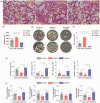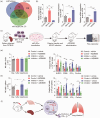The miR-451a facilitates natural killer cell-associated immune deficiency after ischemic stroke
- PMID: 39985210
- PMCID: PMC11846095
- DOI: 10.1177/0271678X251321641
The miR-451a facilitates natural killer cell-associated immune deficiency after ischemic stroke
Abstract
Ischemic stroke is a devastating neurological disease. Brain ischemia impairs systemic immune responses and heightens susceptibility to infections, though the underlying mechanisms remain incompletely understood. Natural killer (NK) cells exhibited decreased frequency and compromised function after acute stage of stroke, resulting in NK cell-associated immune deficiency and increased risk of infection. MicroRNAs (miRNAs) are post-transcriptional molecular modulators. Our previous study revealed a significant upregulation of miR-451a in circulating NK cells from patients with ischemic stroke, but its effects and precise mechanism on immune defense remain elusive. In this study, we observed a substantial elevation of miR-451a level in brain and splenic NK cells in murine model of ischemic stroke miR-451a mimics suppressed NK cell activation and cytotoxicity within the ischemic brain and periphery, including a downregulation of activation marker CD69, and reduced production of effector molecules IFN-γ and perforin. Conversely, miR-451a inhibitor preserved NK cell activation and cytotoxicity, rescuing local inflammation, and reducing bacterial burden in the lung. Pharmacological inhibition of Akt-mTOR pathway with AZD8055 effectively blocked the impacts of miR-451a on NK cell functions. Collectively, these findings suggest miR-451a negatively regulates NK cell cytotoxicity in both the brain and periphery, which could be re-addressed by modulating the Akt-mTOR signaling pathway.
Keywords: Brain ischemia; immune suppression; miR-451a; natural killer cells; poststroke infection.
Conflict of interest statement
Declaration of conflicting interestsThe author(s) declared no potential conflicts of interest with respect to the research, authorship, and/or publication of this article.
Figures





References
-
- Go AS, Mozaffarian D, Roger VL, et al. Executive summary: heart disease and stroke statistics–2014 update: a report from the American Heart Association. Circulation 2014; 129: 399–410. - PubMed
-
- Kwan J, Pickering RM, Kunkel D, et al. Impact of stroke-associated infection on long-term survival: a cohort study. J Neurol Neurosurg Psychiatry 2013; 84: 297–304. - PubMed
MeSH terms
Substances
LinkOut - more resources
Full Text Sources
Medical
Miscellaneous

